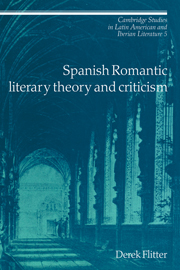Book contents
- Frontmatter
- Contents
- Preface
- List of abbreviations
- Introduction
- 1 Böhl von Faber and the establishment of a traditionalist Romanticism
- 2 The consolidation of Romantic ideas: 1820–1833
- 3 The exiles, liberal Romanticism and developments in criticism
- 4 Condemnation and clarification in the literary debate
- 5 Reaffirmation of Schlegelian principles in literary criticism
- 6 The religious spirit in literary ideas and the influence of Chateaubriand
- 7 The perception of literature's rôle in society
- 8 Romantic traditionalism in the work of Fernán Caballero
- 9 Conclusions: The mid-century
- Notes
- Bibliography
- Index
8 - Romantic traditionalism in the work of Fernán Caballero
Published online by Cambridge University Press: 02 November 2009
- Frontmatter
- Contents
- Preface
- List of abbreviations
- Introduction
- 1 Böhl von Faber and the establishment of a traditionalist Romanticism
- 2 The consolidation of Romantic ideas: 1820–1833
- 3 The exiles, liberal Romanticism and developments in criticism
- 4 Condemnation and clarification in the literary debate
- 5 Reaffirmation of Schlegelian principles in literary criticism
- 6 The religious spirit in literary ideas and the influence of Chateaubriand
- 7 The perception of literature's rôle in society
- 8 Romantic traditionalism in the work of Fernán Caballero
- 9 Conclusions: The mid-century
- Notes
- Bibliography
- Index
Summary
Cecilia Böhl, under her chosen pseudonym of Fernán Caballero, captured the attention of the Spanish literary world in the most striking fashion. The year of 1849 witnessed the publication of four novels and several shorter pieces by this author of seemingly extraordinary fecundity.1 What critics and readers alike did not realise was that Cecilia Bohl had been writing steadily since the 1820s; her novel La familia de Alvareda, for example, had been completed by 1828. Nevertheless, her appearance upon the Spanish literary scene was a late one – she was fifty-two years old at the time of the serialisation of La gaviota. Cecilia had already published her short story Una madre in El Artista in 1835 under the initials ‘C. B.’, and Sola had been published in German in 1840, but she remained unknown until 1849. Her work is often hailed as having paved the way for the emergence in Spain of the realist novel, but more important in the context of the present study is the way in which Fernan Caballero's costumbrismo links with the Romantic conceptual pattern prominent in literary criticism.
Javier Herrero's lucid study established several important affinities between the outlook of Cecilia Böhl and the attitudes earlier expressed by her father Johann Nikolaus, ably linking Fernan Caballero, and specifically La familia de Alvareda, with the prevailing current of historical Romanticism.
- Type
- Chapter
- Information
- Spanish Romantic Literary Theory and Criticism , pp. 151 - 174Publisher: Cambridge University PressPrint publication year: 1991



